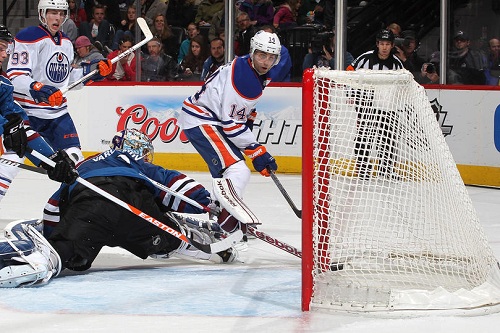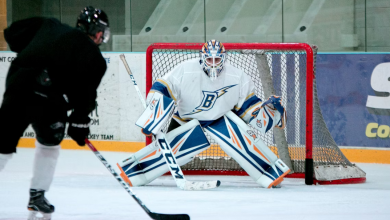Oilers Beat Avalanche, End Losing Streak

The Edmonton Oilers entered the Pepsi Center on Friday, April 19th, desperate to beat the Colorado Avalanche and turn their disastrous six game losing streak around. The Oilers tend to play very well against the Avalanche, who sometimes struggle with defense, allowing the Oilers to get a lot of great opportunities if they use their skill and speed to their advantage. They’ve beaten them in three of their four match-ups, and tonight increased that statistic to four out of five.
Though there was a handful of injuries and players out – Petrell out with a high ankle sprain, Hemsky with a foot problem, Belanger still with the groin, and Peckham not travelling with the team due to the flu – the Oilers came in strong.
Devan Dubnyk started between the pipes, and Edmonton managed to get a power-play about thirty seconds into the game. It was a great opportunity to get some good momentum from the very start, and while they failed to convert the power-play, the always high-energy Taylor Hall swooped in and got the first goal of the night 2:33 into the first period, three seconds after the power-play had expired.
Colorado fought back with a goal by PA Parenteau about 7 minutes in, tying the game up.
Halfway through the period, the Avalanche were outshooting the Oilers an unsettling 13 to 4. Dubnyk was making some great saves, but the Oilers really needed to get some more shots and make chances in order to regain the lead.
The Oilers’ Jordan Eberle finally turned up the pressure and got a beautiful backhand goal at 14:13, bringing the Oilers back in the lead.

(Photo by Michael Martin/NHLI via Getty Images)
Whether it was their strong play previously against this team, or that six losses in a row was just becoming too much to bear, the Oilers came into the second period determined. Ryan Nugent-Hopkins, assisted by Eberle, made a wrist shot about 5 minutes into the second period and increased the Oilers’ lead. They played strong and were rewarded by another goal, again by Jordan Eberle, with about five minutes remaining in the second period.
The Oilers entered the third period with a comfortable 4-1 lead, and managed to maintain it despite being outshot 9 to 3 by a determined-to-rally Colorado.
The Oilers were in control again this period, with the only unfortunate incident being a shot that travelled up Jeff Petry’s stick to hit him in the face.
Colorado yanked their goalie in favor of going 6 on 4 when granted a power-play with very little time to go, but were ultimately unsuccessful as Dubnyk made a phenomenal sprawling save with 2 minutes remaining.
Coach Ralph Krueger commented on Eberle, who made two of the night’s goals and a great assist, in a post-game interview, saying that “his skill-set rises so much when we start to move the puck with speed. It was good to see him have success.” Eberle himself commented on his frustrated state entering the game, saying that “I was just pissed off after losing six in a row. Nothing was going in for me so it was nice to finally get things going.”
All the Oilers seemed to come out of tonight’s game pleased with their play and hopeful for their ability to finish the season strong. Captain Shawn Horcoff attributed their victory to “just effort. We played harder and more focused. We pushed hard in the second period and took the game over.” Sam Gagner made a similar comment: “We just competed and stuck to the game plan all night. Now we have to continue that.”
The Oilers will face the Anaheim Ducks on Sunday, April 21.

